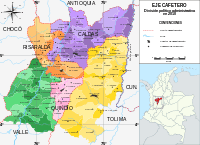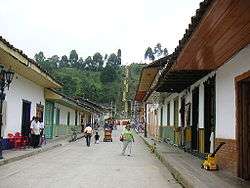Colombian coffee growing axis
| Coffee Cultural Landscape of Colombia | |
|---|---|
| Name as inscribed on the World Heritage List | |
|
Coffee landscape. | |
| Type | Cultural |
| Criteria | v, vi |
| Reference | 1121 |
| UNESCO region | Latin America and the Caribbean |
| Inscription history | |
| Inscription | 2011 (35th Session) |
The Colombian coffee Region (Spanish: Eje Cafetero), also known as the Coffee Triangle (Spanish: Triángulo del Café) is a part of the Colombian Paisa region in the rural area of Colombia, famous for growing and production of a majority of the Colombian coffee, considered by some as the best coffee in the world. There are three departments in the area: Caldas, Quindío and Risaralda. The most visited cities are Manizales, Armenia and Pereira.
History of Coffee
It began growing coffee beans commercially in Colombia in Salazar de las Palmas, Norte de Santander and in the twentieth century was the primary product within Colombian exports. In 1999 represented 3.7% of gross domestic product and 37% of agricultural employment. The main coffee producing departments are: Nariño, Norte de Santander, Antioquia, Valle del Cauca, Huila, Tolima, Caldas, Risaralda, Quindio and Cundinamarca.
The area between the departments of Caldas, Risaralda and Quindío is known as the Coffee Zone because of the large development experienced by the cultivation of this product. This region was strongly affected by an earthquake of 6.4 degrees on the Richter scale registered January 25, 1999, and subsequently the region economically recovered rapidly.
Overview
Weather conditions (8 °C to 24 °C), geographical (Andean Rainforest) and this geological region, determine the production of high quality coffee, with relatively short harvest periods. Farmers in the area have developed techniques for growing, harvesting and processing of grain, and all done "grain by grain", and have retained this form of processing industry despite new techniques of mass agricultural industrialization.
The famous advertising icon "Juan Valdez", represented by a farmer paisa wearing carriel, hat aguadeño and poncho, and accompanied by a mule, has become a triumph of advertising communication. Juan Valdez has been considered in United States as the advertising image of greater recall among the inhabitants of that country in the year 2005.
“Coffee Cultural Landscape” in Colombia.
“The coffee axis” and “The coffee triangle”, is different from the “Coffee Cultural Landscape”(es: Paisaje Cultural Cafetero) in Colombia. The “Coffee Cultural Landscape”, inscribed on the World Heritage List by UNESCO, 2011, is different from “The coffee axis” and “The coffee triangle”.



Tourist attractions

.jpg)
The region has developed major theme parks. One of them, the Colombian National Coffee Park located in the town of Montenegro in Quindio. The area is also the Museum of Culture Coffee, showing the process of grain production to savor a traditional Colombian coffee, this museum, like all the other theme parks are a replica of the colonial city, where tourists enjoy dance performances and traditional music, panoramic view from cable car with its lush landscape, and various rides.
Another theme park unique in Colombia is the National Park of Culture Agriculture - 'Panaca', also located in the Municipality of Quimbaya in Quindio. Its key feature is that, unlike zoos, visitors are immersed in a personal and direct contact with farm animals and also enjoy scheduled activities and events with those animals.
The Matecaña City Zoo in Pereira, is one of the most important traditional zoos in Colombia and South America, has 150 species and 800 individuals, distributed in 239 mammals, 172 birds, 57 fish, 111 reptiles and 5 Of note, the high rate of reproduction, making even a few years ago the crossing of an African lion and a Bengal tiger, resulting in the 'Ligre'. It also has the important Museum of Nature within.
Other attractions in the area include:
- 'Botanical Garden of the University of Pereira' as one of the largest in Colombia as the only listed by the BGCI as natural or Sivestre, but also for being one of the orchid s in the world.
- 'Santuario' is one of the most characteristic towns of the region, is known for its tradition paisa's architecture and streets. It is close to PNN Tatamá.
- 'Thermal Santa Rosa de Cabal', a "Spa" Spa for bathing in hot springs and different activities for relaxation and body care.
- 'Rafting on the Rio la Vieja': Walking the Rio La Vieja on the border between the departments of Valle del Cauca and Quindío, from the town of Quimbaya.
- ' Extreme Sports' Tour operators in the region offer kayaking on the River Barragan, paragliding in Calarcá, among other sports.
- 'Cocora Valley' in Salento, home of the national tree Palma wax Quindío one of the most beautiful spots around the axis coffee one of the entry points to Los Nevados National Natural Park where there are also entitled to stay and camp sites.
- ' Quindío Botanical Gardens', located in the town of Calarcá, where you can also see in the butterfly with the largest exhibition of butterflies in the country.
Main urban centers
Tourism
- Colombian National Coffee Park Montenegro
- Nevado del Ruiz. Manizales
- PANACA Parque
- Cocora valle, Salento. Quindío
- Matecaña City Zoo
Offers some trekking and the chance to see some of Colombia's top coffee cultivating land as well as the country's native palm tree - the Wax Palm, which grows up to 60 metres tall.
See also
- Juan Valdez (International gourmet coffee brand)
- Pereira, Risaralda (Colombian City)
- Armenia, Quindío (Colombian City)
- 1999 Armenia earthquake
- Manizales, Caldas (Colombian City)
- Risaralda (Colombian department)
- Quindío (Colombian department)
- Caldas (Colombian department)
- Antioquia (Colombian department)
- Coffee production in Colombia
-
 Colombia portal
Colombia portal -
 Coffee portal
Coffee portal
Gallery Colombian National Coffee Park
 Coffee process museum
Coffee process museum Panoramic gondola lift
Panoramic gondola lift Folkloric House
Folkloric House View
View- Bamboo Forest
- Antioquia Railway Station
- Railway Station
- Aerial View
- View
- Statues
References
External links
| Wikimedia Commons has media related to Colombian Coffee-Growers Axis. |
| Wikivoyage has a travel guide for Zona Cafetera. |
- The region's official tourism portal (English)
- Coffee region travel page on Colombia Reports (English)
- Coffee region travel page on Colombia Eco Travel (English)
Coordinates: 5°28′18″N 75°40′54″W / 5.47167°N 75.68167°W
